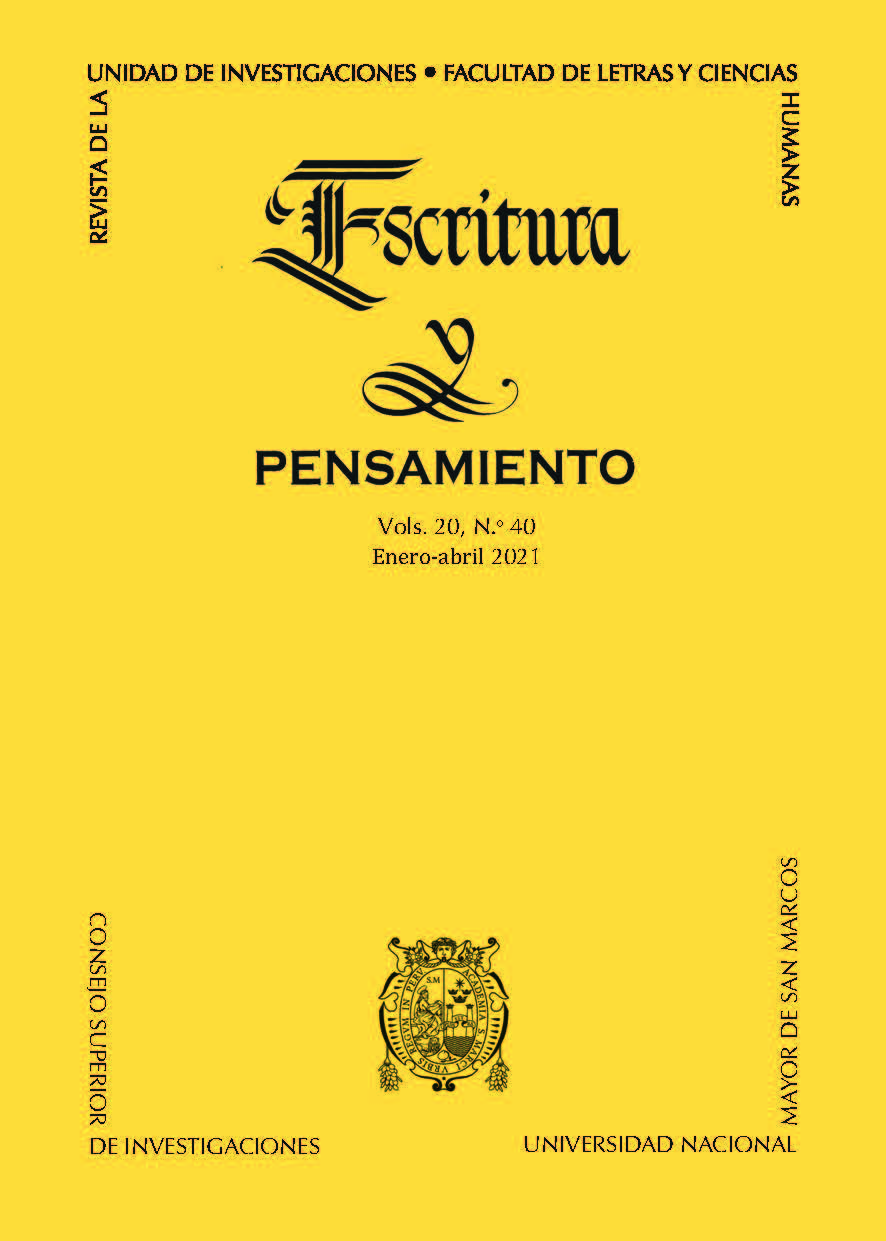Tradition and colloquialism: A reading to understand the development of Nicanor Parra´s poetry in four poetry books
DOI:
https://doi.org/10.15381/escrypensam.v20i40.20059Keywords:
Nicanor Parra, Chilean poetry, modernism, avant-garde, antipoetryAbstract
This article studies the interaction between tradition and colloquialism in Cancionero sin nombre (1937), Poemas y Antipoemas (1954), La cueca Larga (1958) and Manifiesto (1963) by Nicanor Parra. These texts are studied considering Belic's proposals in Verso español y verso europeo regarding free verse. Likewise, we apply what Antonio Quilis points out in Métrica española for the metrical and rhythmic analysis of the selected poems. The hypothesis of this article is that both colloquialism and tradition converge in the free verse advocated by the Chilean poet. In this sense, this paper present, first, a general approach to Nicanor Parra's work, followed by a comparative analysis of the poetry books and, finally, the conclusions.
References
Belic, O. (2000). Verso español y verso europeo. Introducción a la teoría del verso español en el contexto europeo. Santafé de Bogotá: Publicaciones del Instituto Caro y Cuervo.
Claro, S.; Peña, C.; & Quevedo, I. (1994). Chilena o cueca tradicional de acuerdo con las enseñanzas de don Fernando González Marabolí. Santiago de Chile: CIP - Pontificia Universidad Católica de Chile
Espinosa Guerra, J. (2005). Poesía Chilena: El Grupo de Poetas del ´70 o la supuesta Generación del ´80. Revista Galerna (Nueva Jersey), (3). http://www.letras.mysite.com/je240905.htm
Lago, T. (1939). 8 nuevos poetas chilenos. Santiago de Chile: Universidad de Chile. https://libros.uchile.cl/files/presses/1/monographs/1006/submission/proof/ 34/index.html
Montes Brunet, H. (2014). Tradición y antitradición en Nicanor Parra / Tradition and antitradition in Nicanor Parra. Atenea, (510), 15-21. https://www.proquest.com/scholarly-journals/tradición-y-antitradición-en-nicanor-parra/docview/1640564010/se-2?accountid=12268
Parra, N. (1937). Cancionero sin nombre. Santiago de Chile: Nascimiento.
Parra, N. (1954). Poemas y Antipoemas. Santiago de Chile: Nascimiento.
Parra, N. (1963). Manifiesto. Santiago de Chile: Nascimiento.
Parra, N. (1969). Obra gruesa. Santiago de Chile: Editorial Universitaria.
Pfeiffer Augurto, E. (2020). Aproximación a la primera etapa escritural de Nicanor Parra, 1935-1946. Anales De Literatura Chilena, (33), 239-265. https://www.proquest.com/scholarly-journals/aproximación-la-primera-etapa-escritural-de/docview/2436134312/se-2?accountid=12268
Quilis, A. (1983). Métrica española [3ª. Ed.]. Madrid: Ediciones Alcalá
Salvador, A. (1992). La antipoesía entre el neovanguardismo y la posmodernidad. Revista Iberoamericana, 58(159), 611-622. doi: https://doi.org/10.5195/reviberoamer.1992.5067
Silva Acevedo, M. (2015). Poesía y antipoesía de Nicanor Parra. Revista Chilena de literatura, (91), 137-139. https://www.redalyc.org/articulo.oa?id=3602/360243360010
Vidales, L. (2004). “Confesión de un aprendiz de siglo”. En Müller-Bergh, K. y Mendoca, G. (ed.). Vanguardia latinoamericana. Historia, crítica y documentos. Tomo III. Madrid – Frankfurt am Main: Iberoamericana – Vervuert.
Williams, R. (2000). Marxismo y literatura [2ª. Ed.]. Barcelona: Ediciones Península.
Downloads
Published
Issue
Section
License
Copyright (c) 2021 Sara Gabriela Galindo Gonzales

This work is licensed under a Creative Commons Attribution 4.0 International License.
AUTHORS RETAIN THEIR RIGHTS:
a. The authors retain their trademark and patent rights, and also over any process or procedure described in the article.
b. The authors retain the right to share, copy, distribute, execute and publicly communicate the article published in the Escritura y Pensamiento (for example, place it in an institutional repository or publish as part a book), with acknowledgment of its initial publication by Escritura y Pensamiento.
c. Authors retain the right to make a subsequent publication of their work, to use the article or any part of it (for example: a compilation of their work, lecture notes, thesis, or for a book), provided that they indicate the source of publication (authors of the work, journal, volume, number and date).





